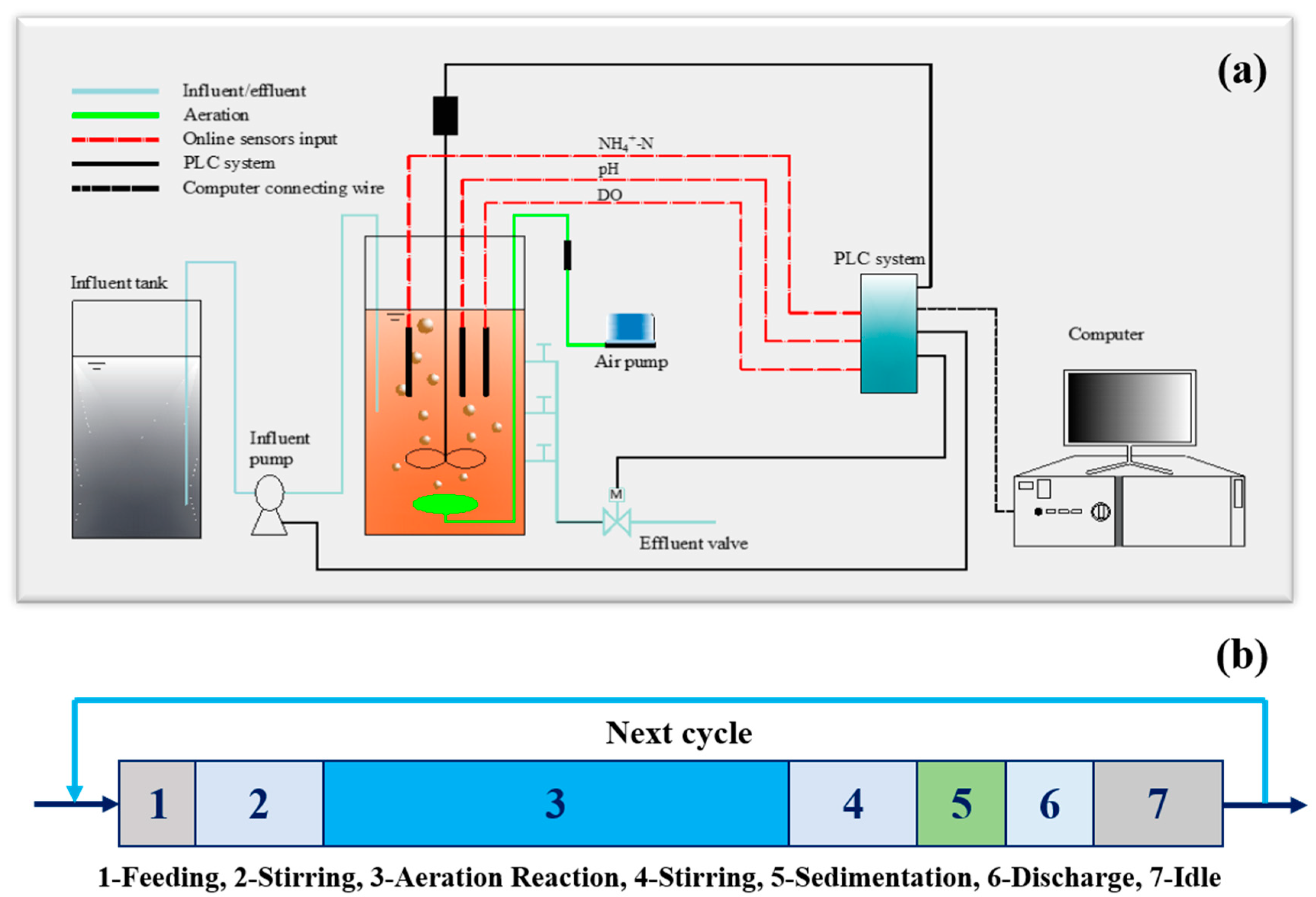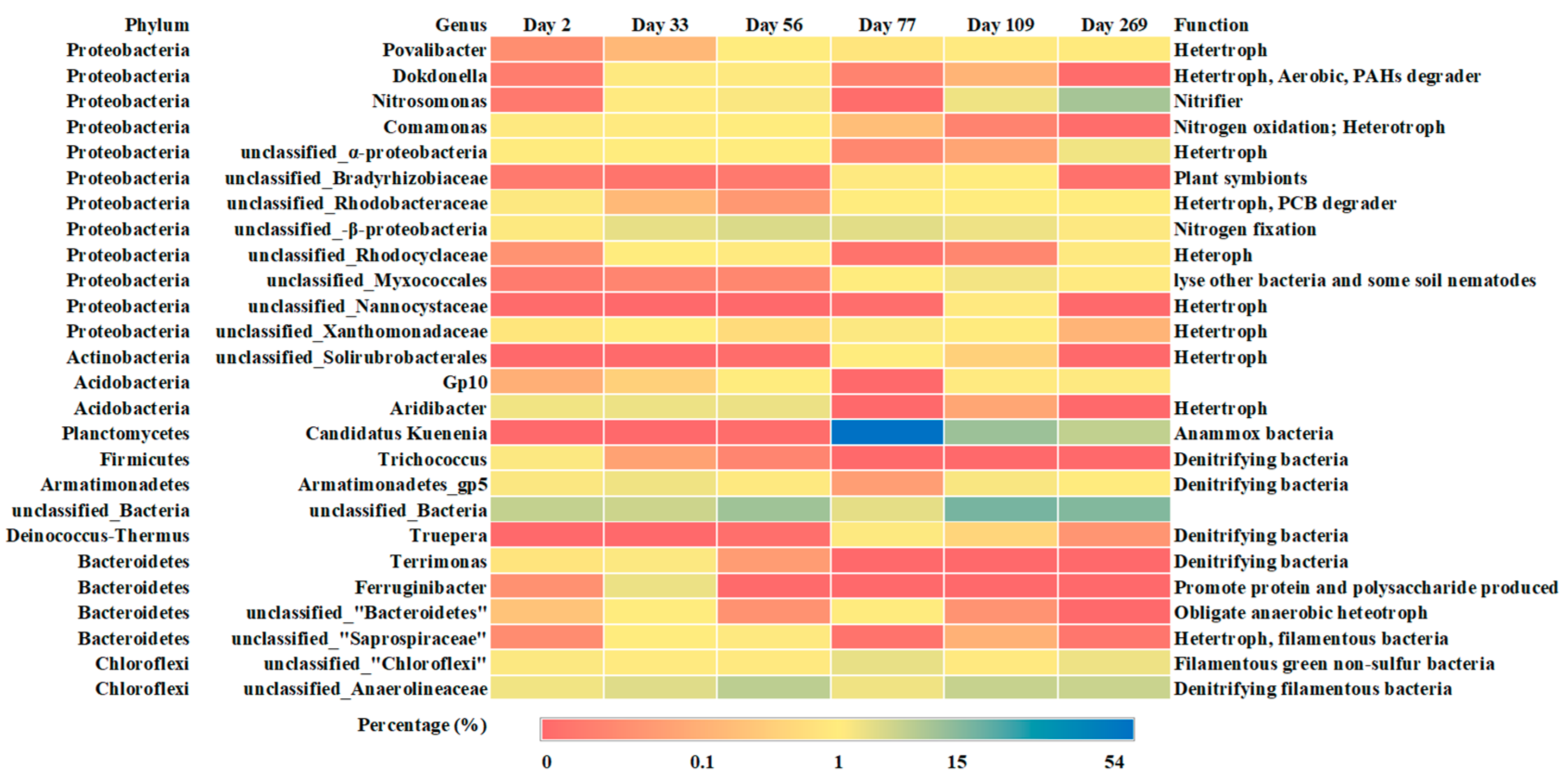Is Anoxic Operation Effective to Control Nitrate Build-Up and Sludge Loss for the Combined Partial Nitritation and Anammox (CPNA) Process?
Abstract
:1. Introduction
2. Materials and Methods
2.1. Lab-Scale Reactor Setup and Its Operation
2.1.1. Set-Up
2.1.2. Influent and Seeding Sludge
2.1.3. Experimental Operation
2.2. Activity Analysis of AOB, NOB and Anammox
2.3. Sludge Sampling, High-Throughput Sequencing and Quantitative Real-Time PCR
2.4. Analysis of Physical-Chemical Parameters
2.5. Statistical Analysis
3. Results
3.1. Performance of Reactor Start-Up and Nitrogen Removal
3.1.1. Start-Up of PN
3.1.2. Nitrogen Removal
3.1.3. Activity of AOB, NOB and Anammox
3.2. Sludge Loss
3.2.1. Sludge Loss
3.2.2. Sludge PSD and Morphology
3.3. Abundances of Functional Bacteria and Genes Related to Nitrogen Transformation
3.4. Evolution in Microbial Communities
3.5. The Analysis of NH2OH’s Effect and Possible Sludge Loss Reasons in the CPNA System
4. Conclusions
Supplementary Materials
Author Contributions
Funding
Acknowledgments
Conflicts of Interest
References
- Lackner, S.; Gilbert, E.M.; Vlaeminck, S.E.; Joss, A.; Horn, H.; van Loosdrecht, M.C. Full-scale partial nitritation/anammox experiences-an application survey. Water Res. 2014, 55, 292–303. [Google Scholar] [CrossRef] [PubMed]
- Speth, D.R.; In’t Zandt, M.H.; Guerrero-Cruz, S.; Dutilh, B.E.; Jetten, M.S. Genome-based microbial ecology of anammox granules in a full-scale wastewater treatment system. Nat. Commun. 2016, 7, 11172. [Google Scholar] [CrossRef] [PubMed]
- Jardin, N.; Hennerkes, J. Full-scale experience with the deammonification process to treat high strength sludge water—A case study. Water Sci. Technol. 2012, 65, 447–455. [Google Scholar] [CrossRef] [PubMed]
- Wett, B. Solved upscaling problems for implementing deammonification of rejection water. Water Sci. Technol. 2006, 53, 121–128. [Google Scholar] [CrossRef] [Green Version]
- Yu, Y.C.; Gao, D.W.; Tao, Y. Anammox start-up in sequencing batch biofilm reactors using different inoculating sludge. Appl. Microbiol. Biotechnol. 2013, 97, 6057–6064. [Google Scholar] [CrossRef]
- Huang, X.; Urata, K.; Wei, Q.; Yamashita, Y.; Hama, T.; Kawagoshi, Y. Fast start-up of partial nitritation as pre-treatment for anammox in membrane bioreactor. Biochem. Eng. J. 2016, 105, 371–378. [Google Scholar] [CrossRef]
- Qiu, S.; Hu, Y.; Liu, R.; Sheng, X.; Chen, L.; Wu, G.; Hu, H.; Zhan, X. Start up of partial nitritation-anammox process using intermittently aerated sequencing batch reactor: Performance and microbial community dynamics. Sci. Total Environ. 2019, 647, 1188–1198. [Google Scholar] [CrossRef]
- Xu, G.; Xu, X.; Yang, F.; Liu, S.; Gao, Y. Partial nitrification adjusted by hydroxylamine in aerobic granules under high DO and ambient temperature and subsequent Anammox for low C/N wastewater treatment. Chem. Eng. J. 2012, 213, 338–345. [Google Scholar] [CrossRef]
- Li, J.; Zhang, L.; Liu, J.; Lin, J.; Peng, Y. Hydroxylamine addition and real-time aeration control in sewage nitritation system for reduced start-up period and improved process stability. Bioresour. Technol. 2019, 294, 122183. [Google Scholar] [CrossRef]
- Liu, W.; Yang, D. Evaluating the feasibility of ratio control strategy for achieving partial nitritation in a continuous floccular sludge reactor: Experimental demonstration. Bioresour. Technol. 2017, 224, 94–100. [Google Scholar] [CrossRef]
- Tokutomi, T.; Shibayama, C.; Soda, S.; Ike, M. A novel control method for nitritation: The domination of ammonia-oxidizing bacteria by high concentrations of inorganic carbon in an airlift-fluidized bed reactor. Water Res. 2010, 44, 4195–4203. [Google Scholar] [CrossRef] [PubMed]
- Van der Star, W.R.; van de Graaf, M.J.; Kartal, B.; Picioreanu, C.; Jetten, M.S.; van Loosdrecht, M.C. Response of anaerobic ammonium-oxidizing bacteria to hydroxylamine. Appl. Environ. Microb. 2008, 74, 4417–4426. [Google Scholar] [CrossRef] [PubMed] [Green Version]
- Wang, Y.; Wang, Y.; Wei, Y.; Chen, M. In-situ restoring nitrogen removal for the combined partial nitritation-anammox process deteriorated by nitrate build-up. Biochem. Eng. J. 2015, 98, 127–136. [Google Scholar] [CrossRef]
- Joss, A.; Salzgeber, D.; Eugster, J.; Konig, R.; Rottermann, K.; Burger, S.; Fabijan, P.; Leumann, S.; Mohn, J.; Siegrist, H.; et al. Full-scale nitrogen removal from digester liquid with partial nitritation and anammox in one SBR. Environ. Sci. Technol. 2009, 43, 5301–5306. [Google Scholar] [CrossRef]
- Joss, A.; Derlon, N.; Cyprien, C.; Burger, S.; Szivak, I.; Traber, J.; Siegrist, H.; Morgenroth, E. Combined nitritation-anammox: Advances in understanding process stability. Environ. Sci. Technol. 2011, 45, 9735–9742. [Google Scholar] [CrossRef] [PubMed]
- Martins, A.M.; Pagilla, K.; Heijnen, J.J.; van Loosdrecht, M.C. Filamentous bulking sludge—A critical review. Water Res. 2004, 38, 793–817. [Google Scholar] [CrossRef]
- Wang, Y.Y.; Wang, H.Y.; Zhang, J.Y.; Yao, L.; Wei, Y.S. Deciphering the evolution of the functional genes and microbial community of the combined partial nitritation-anammox process with nitrate build-up and its in situ restoration. RSC Adv. 2016, 6, 111702–111712. [Google Scholar] [CrossRef]
- Yongtao, L.V.; Xuan, C.; Wang, L.; Kai, J.; Xiaoqiang, C.; Rui, M.; Xudong, W. Microprofiles of activated sludge aggregates using microelectrodes in completely autotrophic nitrogen removal over nitrite (CANON) reactor. Front. Environ. Sci. Eng. 2016, 10, 390–398. [Google Scholar] [CrossRef]
- Jia, F.; Yang, Q.; Liu, X.; Li, X.; Li, B.; Zhang, L.; Peng, Y. Stratification of extracellular polymeric substances (EPS) for aggregated anammox microorganisms. Environ. Sci. Technol. 2017, 51, 3260–3268. [Google Scholar] [CrossRef]
- Sui, Q.; Wang, Y.; Wang, H.; Yue, W.; Chen, Y.; Yu, D.; Chen, M.; Wei, Y. Roles of hydroxylamine and hydrazine in the in-situ recovery of one-stage partial nitritation-anammox process: Characteristics and mechanisms. Sci. Total Environ. 2020, 707, 135648. [Google Scholar] [CrossRef]
- Zhang, J.; Liu, J.; Lu, T.; Shen, P.; Zhong, H.; Tong, J.; Wei, Y. Fate of antibiotic resistance genes during anaerobic digestion of sewage sludge: Role of solids retention times in different configurations. Bioresour. Technol. 2019, 274, 488–495. [Google Scholar] [CrossRef] [PubMed]
- Caporaso, J.G.; Kuczynski, J.; Stombaugh, J.; Bittinger, K.; Bushman, F.D.; Costello, E.K.; Fierer, N.; Peña, A.G.; Goodrich, J.K.; Gordon, J.I.; et al. QIIME allows analysis of high-throughput community sequencing data. Nat. Methods 2010, 7, 335. Available online: https://www.nature.com/articles/nmeth.f.303#supplementary-information (accessed on 11 April 2010). [CrossRef] [PubMed] [Green Version]
- Magoč, T.; Salzberg, S.L. FLASH: Fast length adjustment of short reads to improve genome assemblies. Bioinformatics 2011, 27, 2957–2963. [Google Scholar] [CrossRef] [PubMed]
- Edgar, R.C.; Haas, B.J.; Clemente, J.C.; Quince, C.; Knight, R. UCHIME improves sensitivity and speed of chimera detection. Bioinformatics 2011, 27, 2194–2200. [Google Scholar] [CrossRef] [Green Version]
- Wang, Q.; Garrity, G.M.; Tiedje, J.M.; Cole, J.R. Naive Bayesian classifier for rapid assignment of rRNA sequences into the new bacterial taxonomy. Appl. Environ. Microbiol. 2007, 73, 5261–5267. [Google Scholar] [CrossRef] [Green Version]
- Eaton, A.; Clesceri, L.S.; Greenberg, A.E.; Franson, M.H. Standard Methods for the Examination of Water and Wastewater, 22nd ed.; American Public Health Association: Washington, DC, USA, 2012. [Google Scholar]
- Lotti, T.; Kleerebezem, R.; Lubello, C.; van Loosdrecht, M.C. Physiological and kinetic characterization of a suspended cell anammox culture. Water Res. 2014, 60, 1–14. [Google Scholar] [CrossRef]
- Sliekers, A.O.; Derwort, N.; Gomez, J.L.C.; Strous, M.; Kuenen, J.G.; Jetten, M.S.M. Completely autotrophic nitrogen removal over nitrite in one single reactor. Water Res. 2002, 36, 2475–2482. [Google Scholar] [CrossRef]
- Harper, W.F., Jr.; Terada, A.; Poly, F.; le Roux, X.; Kristensen, K.; Mazher, M.; Smets, B.F. The effect of hydroxylamine on the activity and aggregate structure of autotrophic nitrifying bioreactor cultures. Biotechnol. Bioeng. 2009, 102, 714–724. [Google Scholar] [CrossRef]
- Henriet, O.; Meunier, C.; Henry, P.; Mahillon, J. Filamentous bulking caused by Thiothrix species is efficiently controlled in full-scale wastewater treatment plants by implementing a sludge densification strategy. Sci. Rep. UK 2017, 7, 1430. [Google Scholar] [CrossRef]
- Ma, Y.; Peng, Y.; Wang, S.; Yuan, Z.; Wang, X. Achieving nitrogen removal via nitrite in a pilot-scale continuous pre-denitrification plant. Water Res. 2009, 43, 563–572. [Google Scholar] [CrossRef]
- Yang, Y.; Zhang, L.; Cheng, J.; Zhang, S.; Li, X.; Peng, Y. Microbial community evolution in partial nitritation/anammox process: From sidestream to mainstream. Bioresour. Technol. 2017, 251, 327–333. [Google Scholar] [CrossRef] [PubMed]
- Hao, X.D.; Heijnen, J.J.; van Loosdrecht, M.C.M. Model-based evaluation of temperature and inflow variations on a partial nitrification-ANAMMOX biofilm process. Water Res. 2002, 36, 4839–4849. [Google Scholar] [CrossRef]
- Vlaeminck, S.E.; Terada, A.; Smets, B.F.; de Clippeleir, H.; Schaubroeck, T.; Bolca, S.; Demeestere, L.; Mast, J.; Boon, N.; Carballa, M.; et al. Aggregate size and architecture determine microbial activity balance for one-stage partial nitritation and anammox. Appl. Environ. Microb. 2010, 76, 900–909. [Google Scholar] [CrossRef] [PubMed] [Green Version]
- Gilbert, E.M.; Muller, E.; Horn, H.; Lackner, S. Microbial activity of suspended biomass from a nitritation-anammox SBR in dependence of operational condition and size fraction. Appl. Microbiol. Biotechnol. 2013, 97, 8795–8804. [Google Scholar] [CrossRef]
- Choi, D.; Cho, S.; Jung, J. Key operating parameters affecting nitrogen removal rate in single-stage deammonification. Chemosphere 2018, 207, 357–364. [Google Scholar] [CrossRef]
- Li, X.R.; Du, B.; Fu, H.X.; Wang, R.F.; Shi, J.H.; Wang, Y.; Jetten, M.S.M.; Quan, Z.X. The bacterial diversity in an anaerobic ammonium-oxidizing (anammox) reactor community. Syst. Appl. Microbiol. 2009, 32, 278–289. [Google Scholar] [CrossRef]
- Thomsen, T.R.; Kjellerup, B.V.; Nielsen, J.L.; Hugenholtz, P.; Nielsen, P.H. In situ studies of the phylogeny and physiology of filamentous bacteria with attached growth. Environ. Microbiol. 2002, 4, 383–391. [Google Scholar] [CrossRef]
- Winkler, M.H.; Boets, P.; Hahne, B.; Goethals, P.; Volcke, E.I. Effect of the dilution rate on microbial competition: R-strategist can win over k-strategist at low substrate concentration. PLoS ONE 2017, 12, e0172785. [Google Scholar] [CrossRef] [Green Version]
- Kindaichi, T.; Yuri, S.; Ozaki, N.; Ohashi, A. Ecophysiological role and function of uncultured Chloroflexi in an anammox reactor. Water Sci. Technol. 2012, 66, 2556. [Google Scholar] [CrossRef] [Green Version]
- Wang, D.; Li, T.; Huang, K.; He, X.; Zhang, X.X. Roles and correlations of functional bacteria and genes in the start-up of simultaneous anammox and denitrification system for enhanced nitrogen removal. Sci. Total Environ. 2019, 655, 1355–1363. [Google Scholar] [CrossRef]
- Caroline, K.; Rolighed, T.T.; Tomasz, M.A.; Halkjær, N.P. Eikelboom’s morphotype 0803 in activated sludge belongs to the genus Caldilinea in the phylum Chloroflexi. Fems Microbiol. Ecol. 2011, 3, 451–462. [Google Scholar]
- Mielcarek, A.; Rodziewicz, J.; Janczukowicz, W.; Dulski, T.; Ciesielski, S.; Thornton, A. Denitrification aided by waste beer in anaerobic sequencing batch biofilm reactor (AnSBBR). Ecol. Eng. 2016, 95, 384–389. [Google Scholar] [CrossRef]
- Niu, W.; Guo, J.; Jing, L.; Ngo, H.H.; Yin, P. Effect of fluctuating hydraulic retention time (HRT) on denitrification in the UASB reactors. Biochem. Eng. J. 2017, 132, 29–37. [Google Scholar] [CrossRef]
- Xu, S.; Yao, J.; Ainiwaer, M.; Hong, Y.; Zhang, Y. Analysis of bacterial community structure of activated sludge from wastewater treatment plants in winter. Biomed. Res. Int. 2018, 2018, 8278970. [Google Scholar] [CrossRef] [PubMed] [Green Version]
- Scheff, G.; Salcher, O.; Lingens, F. Trichococcus flocculiformis gen. nov. sp. nov. A new gram-positive filamentous bacterium isolated from bulking sludge. Appl. Microbiol. Biotechnol. 1984, 19, 114–119. [Google Scholar] [CrossRef]






© 2020 by the authors. Licensee MDPI, Basel, Switzerland. This article is an open access article distributed under the terms and conditions of the Creative Commons Attribution (CC BY) license (http://creativecommons.org/licenses/by/4.0/).
Share and Cite
Wang, H.; Wang, Y.; Zhang, J.; Sui, Q.; Hu, D.; Zuo, F.; Wei, Y. Is Anoxic Operation Effective to Control Nitrate Build-Up and Sludge Loss for the Combined Partial Nitritation and Anammox (CPNA) Process? Processes 2020, 8, 1053. https://doi.org/10.3390/pr8091053
Wang H, Wang Y, Zhang J, Sui Q, Hu D, Zuo F, Wei Y. Is Anoxic Operation Effective to Control Nitrate Build-Up and Sludge Loss for the Combined Partial Nitritation and Anammox (CPNA) Process? Processes. 2020; 8(9):1053. https://doi.org/10.3390/pr8091053
Chicago/Turabian StyleWang, Hongyan, Yuanyue Wang, Junya Zhang, Qianwen Sui, Dazhou Hu, Fumin Zuo, and Yuansong Wei. 2020. "Is Anoxic Operation Effective to Control Nitrate Build-Up and Sludge Loss for the Combined Partial Nitritation and Anammox (CPNA) Process?" Processes 8, no. 9: 1053. https://doi.org/10.3390/pr8091053
APA StyleWang, H., Wang, Y., Zhang, J., Sui, Q., Hu, D., Zuo, F., & Wei, Y. (2020). Is Anoxic Operation Effective to Control Nitrate Build-Up and Sludge Loss for the Combined Partial Nitritation and Anammox (CPNA) Process? Processes, 8(9), 1053. https://doi.org/10.3390/pr8091053






